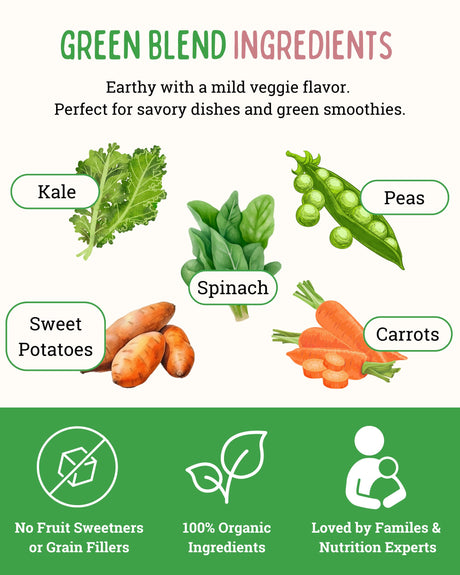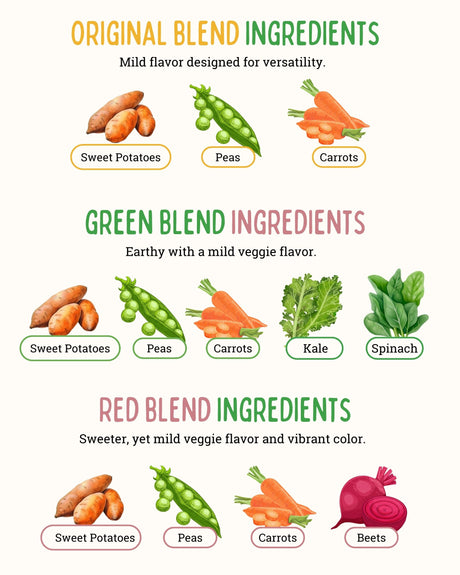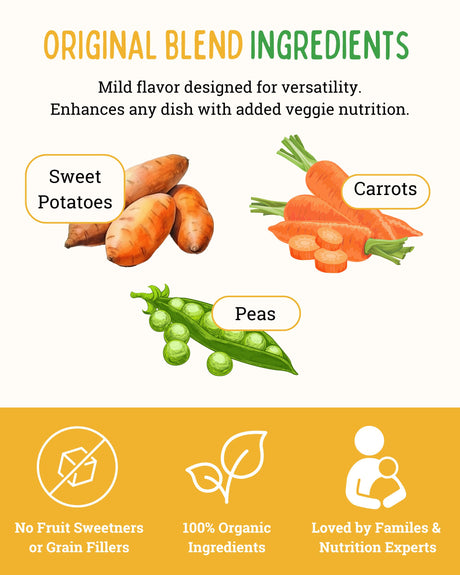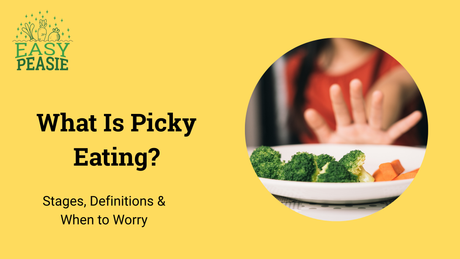Your child gags at broccoli while their sibling happily munches it. You've tried every preparation method, every recipe, every gentle approach, but certain vegetables trigger such intense reactions that you wonder if something more than pickiness is at play.
You might be right. Your child could be a supertaster; someone who experiences tastes, particularly bitter flavors, far more intensely than most people. This isn't behavioral or a phase to outgrow; it's genetic, affecting approximately 25% of the population and making certain vegetables genuinely overwhelming.
Understanding whether your child is a supertaster can transform how you approach vegetables. Instead of feeling frustrated by their "dramatic" reactions or wondering why strategies that work for other kids fail with yours, you can tailor your approach to their actual biological experience. The goal isn't making bitter vegetables less bitter—it's working with your child's taste sensitivity rather than against it.
What Is a Supertaster?
The Science of Taste Sensitivity
Supertasters aren't being difficult or overly dramatic about food; their taste buds literally work differently. They have a higher density of taste receptors, particularly fungiform papillae on their tongues, which contain taste buds. While the average person has about 15-35 taste buds per papilla, supertasters can have significantly more, making every taste experience more intense.
This increased receptor density affects all tastes to some degree, but the impact on bitter taste sensitivity is most pronounced and problematic for food acceptance. What tastes mildly bitter to most people can be overwhelmingly, even painfully bitter to a supertaster.
The Genetic Component
Supertasting ability is largely genetic, linked to variations in the TAS2R38 gene that affects how we perceive bitter compounds, particularly 6-n-propylthiouracil (PROP) and phenylthiocarbamide (PTC). These compounds are present in many vegetables, especially cruciferous ones like broccoli, Brussels sprouts, and kale.
The three taste sensitivity categories:
- Supertasters (25%): Experience intense bitter flavors, have high taste bud density
- Medium tasters (50%): Experience moderate taste intensity, average taste bud density
- Non-tasters (25%): Experience minimal bitter flavors, lower taste bud density
If you or your partner are supertasters, your child has a higher likelihood of being one too. This genetic component explains why some families struggle more with vegetable acceptance than others; it's not just parenting approaches or exposure; it's biology.
How Supertasting Affects Children
For children who are supertasters, eating isn't just about preference; it's about managing genuinely intense sensory experiences. The bitter compounds in vegetables that adults might barely notice can taste profoundly unpleasant to supertaster children.
Common supertaster experiences:
- Gagging or strong reactions to bitter vegetables
- Ability to detect flavors or ingredients others don't notice
- Preference for bland, mild foods
- Sensitivity to food temperatures and textures
- Avoidance of strong-flavored foods like coffee, dark chocolate (in older children/adults)
Children can't articulate that broccoli tastes "five times more bitter" to them than to their sibling. They just know it's awful and refuse it, leading adults to think they're being stubborn when they're actually experiencing genuine sensory overwhelm.
Identifying Supertasters
Signs Your Child Might Be a Supertaster
While genetic testing exists, you can identify likely supertasters through observation of eating patterns and reactions.
Behavioral indicators:
- Consistent rejection of bitter vegetables (broccoli, Brussels sprouts, kale, spinach, cabbage)
- Strong negative reactions even to small amounts
- Ability to detect "hidden" vegetables others don't notice
- Preference for sweet or bland foods
- Sensitivity to food textures and temperatures
- Complaints that foods are "too strong" or "taste weird"
- Limited food variety despite repeated exposure
Physical indicators:
- More taste buds visible on tongue (appears bumpier than average)
- Strong reactions to mint or spicy foods
- Sensitivity to carbonation in drinks
The PROP Test
Scientists use PROP (6-n-propylthiouracil) testing to identify supertasters in research settings. While not typically done at home, understanding the concept helps explain the biology.
PROP is a chemical compound that tastes intensely bitter to supertasters, moderately bitter to medium tasters, and virtually tasteless to non-tasters. This same sensitivity affects how people experience bitter compounds in vegetables.
Age Considerations
Children are more likely to reject bitter vegetables than adults, even if they're not supertasters, because taste perception changes with age. Bitter sensitivity is naturally heightened in childhood as an evolutionary protection against potentially toxic plants.
However, supertaster children show consistently more intense reactions that persist beyond typical developmental pickiness. Their responses are more extreme and don't diminish as quickly with exposure as non-supertaster children's reactions do.
Why This Matters for Vegetable Acceptance
Validation vs. Permissiveness
Understanding supertasting provides crucial validation for parents and children. Your child's reactions aren't manipulation or drama—they're genuine responses to intense sensory input. This knowledge allows you to:
- Reduce guilt about feeding challenges
- Stop approaches that work against biology
- Choose strategies aligned with your child's actual experience
- Explain to extended family why "just try it" doesn't work
- Help your child understand their own responses
This validation doesn't mean giving up on vegetables. It means working smarter with appropriate strategies rather than forcing approaches that cannot succeed given your child's biology.
Setting Realistic Expectations
Supertaster children may never love intensely bitter vegetables, and that's okay. The goal shifts from getting them to eat all vegetables to ensuring adequate vegetable nutrition through:
- Focusing on less bitter vegetable options
- Finding preparation methods that reduce perceived bitterness
- Using concentrated nutrition sources when whole vegetable consumption is very limited
- Building acceptance of milder vegetables first
Strategies for Supertaster Children
Choose Less Bitter Vegetables
Not all vegetables are created equal when it comes to bitterness. Strategic vegetable selection makes an enormous difference for supertasters.
Lower-bitterness vegetables to prioritize:
- Carrots: Naturally sweet with minimal bitterness
- Sweet potatoes: High sweetness, low bitterness
- Corn: Sweet and starchy, well-tolerated
- Peas: Mild and slightly sweet
- Cucumbers: Very mild, high water content
- Bell peppers (especially red/orange/yellow): Sweet rather than bitter
- Butternut squash: Naturally sweet when cooked
- Green beans: Milder than most green vegetables
Higher-bitterness vegetables to approach carefully:
- Broccoli, Brussels sprouts, cabbage, kale, collard greens, arugula, radicchio, turnips
This doesn't mean never offering bitter vegetables, but rather not making them the focus of your vegetable strategy with a supertaster child.
Preparation Methods That Reduce Bitterness
How you prepare vegetables significantly affects perceived bitterness for supertasters.
Bitterness-reducing techniques:
Roasting: High-heat roasting caramelizes natural sugars in vegetables, creating sweetness that balances bitterness. This works especially well for Brussels sprouts, broccoli, and carrots.
Adding fat: Butter, olive oil, or cheese can coat taste buds and reduce bitter compound contact. Fat also carries and enhances sweet flavors over bitter ones.
Incorporating sweet elements: Pairing vegetables with naturally sweet foods (fruits, honey, maple syrup in small amounts) can help balance bitter perception.
Blanching then sautéing: Brief boiling removes some bitter compounds before final cooking, reducing overall bitterness.
Cheese sauces: Cheese provides fat, salt, and savory flavors that mask bitterness effectively.
Smaller pieces: Finely chopping or pureeing vegetables reduces the intensity of any single bite, making bitterness less overwhelming.
Temperature Considerations
Temperature affects taste perception. For supertasters, serving temperature can make vegetables more or less tolerable.
Temperature effects:
- Cold or room temperature vegetables often taste less bitter than hot ones
- Steaming hot vegetables release more bitter compounds into the air (intensifying the experience)
- Roasted vegetables served slightly warm rather than hot may be more acceptable
Texture Modifications
Many supertaster children are also texture-sensitive. Adjusting textures can make vegetables more acceptable even if some bitterness remains.
Texture strategies:
- Raw vegetables often have different texture and less intense flavor than cooked
- Roasted to crispy rather than soft and mushy
- Pureed into smoothies or sauces where texture disappears
- Cut into appealing shapes or sizes
Gradual Exposure Without Pressure
Even with supertasters, continued exposure matters—but it must be pressure-free and realistic.
Effective exposure strategies:
- Keep less-bitter vegetables in regular rotation
- Offer tiny portions of more bitter vegetables alongside accepted foods
- Allow observation without eating (on the table but not on their plate)
- Respect refusals without making them dramatic events
- Celebrate any interaction (touching, smelling, tasting) as progress
For supertasters, acceptance timelines are typically longer than average. What takes a non-supertaster child 10-15 exposures might take a supertaster 30-40 or more.
Nutritional Solutions for Supertasters
Ensuring Adequate Nutrition with Limited Vegetables
When a supertaster child's vegetable acceptance is very limited, ensuring adequate nutrition becomes crucial.
Nutritional strategies:
Focus on accepted vegetables: If your child eats carrots and corn but nothing else, make those vegetables a daily part of meals. Limited variety is better than no vegetables.
Use vegetable-based products: Products like Easy Peasie Veggie Powder Blends provide concentrated vegetable nutrition from less-bitter vegetables (carrots, peas, sweet potatoes) plus nutrient-dense greens in forms where bitterness is minimized. Two tablespoons provide nutrients equivalent to a cup of vegetables, offering nutritional security while working on whole vegetable acceptance.
Prioritize nutrient-dense options: When vegetable variety is limited, choose the most nutritionally valuable options. Sweet potatoes and carrots provide excellent vitamin A, while peas offer protein and fiber.
Consider timing: Some children tolerate vegetables better at certain times of day. Experiment with offering vegetables for lunch rather than dinner, or as after-school snacks.
Vitamin and Mineral Considerations
Limited vegetable intake can create specific nutritional gaps to monitor.
Nutrients to watch:
- Vitamin A: Carrots and sweet potatoes are excellent sources
- Vitamin C: Bell peppers and strawberries provide good amounts
- Fiber: Peas, corn, and whole grains can help
- Folate: If greens aren't eaten, consider fortified grains
- Iron: May need attention if dark leafy greens are refused
Work with your pediatrician to monitor growth and nutrition, especially if vegetable variety is very limited.
Long-Term Outlook for Supertaster Children
How Taste Sensitivity Changes with Age
The good news: supertasting doesn't remain equally intense throughout life. Taste bud density and sensitivity typically decrease with age, meaning many supertaster children find vegetables more tolerable as they grow older.
Age-related changes:
- Childhood: Peak sensitivity, strongest reactions
- Adolescence: Gradual decrease in sensitivity begins
- Young adulthood: Continued moderation of taste intensity
- Adulthood: Many adult supertasters tolerate vegetables better than in childhood
This doesn't mean supertaster children will suddenly love Brussels sprouts at age 16, but vegetables that were intolerable at 5 may become acceptable at 15.
Building Long-Term Acceptance
Even with biological challenges, repeated exposure combined with maturation can expand vegetable acceptance over time.
Long-term strategies:
- Continue offering even rejected vegetables occasionally
- Revisit previously refused vegetables every 6-12 months
- Try new preparation methods as they mature
- Involve them in growing and preparing vegetables
- Model eating a variety of vegetables without pressure
Adult Supertasters
Many adults are supertasters and manage it successfully by understanding their taste preferences and making informed choices.
Adult supertaster strategies:
- Gravitating toward less bitter vegetables naturally
- Using preparation methods that minimize bitterness
- Balancing vegetable intake with fruits and other nutrients
- Being selective about which vegetables to prioritize
Your supertaster child will eventually develop their own strategies for managing their sensitivity while maintaining adequate nutrition.
Supporting Your Supertaster Child
Explaining to Others
Extended family and others may not understand why your child reacts so strongly to vegetables, leading to unhelpful comments or pressure.
Explaining supertasting: "My child is a supertaster, which means they have more taste buds than most people. Bitter vegetables genuinely taste much stronger to them—it's genetic, not behavioral. We're working on vegetable acceptance in ways that respect their biology."
This explanation provides facts without inviting debate, helping others understand this isn't permissive parenting or a phase.
Helping Your Child Understand
Age-appropriate explanations help children understand their own experiences.
For young children: "Your tongue has extra taste sensors that make some foods taste really strong. That's why broccoli tastes super yucky to you but okay to your brother. It's not bad—your tongue just works differently."
For older children: "You're what scientists call a 'supertaster.' You have more taste buds than most people, which makes you really good at tasting things but also means bitter foods are more intense for you. That's why vegetables like kale taste awful to you but fine to others—you're literally tasting them differently."
Understanding their biology helps children feel less broken or difficult, recognizing their responses as normal variations rather than personal failings.
Reducing Mealtime Stress
Accepting your child's supertaster status reduces family stress around eating.
Stress-reduction strategies:
- Stop forcing intensely bitter vegetables
- Focus on vegetables they can tolerate
- Provide nutritional support through accepted foods and appropriate supplements
- Celebrate small victories (touching, smelling, or tasting counts as progress)
- Remember this is biology, not behavior
When to Seek Additional Help
While supertasting itself isn't a medical condition requiring treatment, some supertaster children develop more complex feeding challenges needing professional support.
Consider professional help if:
- Your child eats fewer than 20 total foods
- Growth or nutritional deficiencies are concerns
- Mealtime anxiety is significant for child or family
- Social situations are severely impacted
- No improvement occurs despite appropriate strategies
Feeding therapists experienced with sensory challenges can provide specialized support for supertaster children with more significant feeding difficulties.
Moving Forward with Understanding
Discovering your child is a supertaster provides valuable context for their vegetable resistance. This isn't failure to properly introduce foods or insufficient parental persistence; it's biology requiring adapted approaches.
Success with supertaster children looks different than with average tasters. It means finding the vegetables they can tolerate, using preparation methods that work with their sensitivity, and ensuring adequate nutrition through realistic strategies rather than forcing approaches that cannot succeed.
Your supertaster child can have adequate nutrition and healthy eating patterns without loving bitter vegetables. By understanding their taste biology and adapting your approach accordingly, you reduce struggle while supporting their nutritional needs and building whatever vegetable acceptance their biology allows.
The vegetables they refuse now may become acceptable later as their sensitivity moderates with age. Until then, working with their biology rather than against it creates more peaceful mealtimes and better long-term outcomes.
This article is for educational purposes only and does not constitute medical advice. Always consult with your child's healthcare provider for concerns about eating patterns, growth, or development.
Research References
The scientific information in this article is based on peer-reviewed research in taste genetics and child nutrition:
Bartoshuk, L. M., Duffy, V. B., & Miller, I. J. (1994). PTC/PROP tasting: Anatomy, psychophysics, and sex effects. Physiology & Behavior, 56(6), 1165-1171.
Bell, K. I., & Tepper, B. J. (2006). Short-term vegetable intake by young children classified by 6-n-propylthoiuracil bitter-taste phenotype. The American Journal of Clinical Nutrition, 84(1), 245-251.
Duffy, V. B., Davidson, A. C., Kidd, J. R., et al. (2004). Bitter receptor gene (TAS2R38), 6-n-propylthiouracil (PROP) bitterness and alcohol intake. Alcoholism: Clinical and Experimental Research, 28(11), 1629-1637.
Keller, K. L., & Adise, S. (2016). Variation in the Ability to Taste Bitter Thiourea Compounds: Implications for Food Acceptance, Dietary Intake, and Obesity Risk in Children. Annual Review of Nutrition, 36, 157-182.
Mennella, J. A., Pepino, M. Y., & Reed, D. R. (2005). Genetic and environmental determinants of bitter perception and sweet preferences. Pediatrics, 115(2), e216-e222.
Additional Note: The distribution of supertasters (25%), medium tasters (50%), and non-tasters (25%) in the population has been consistently documented across multiple studies in taste genetics research, beginning with foundational work at Yale University and confirmed in subsequent population-based studies.











